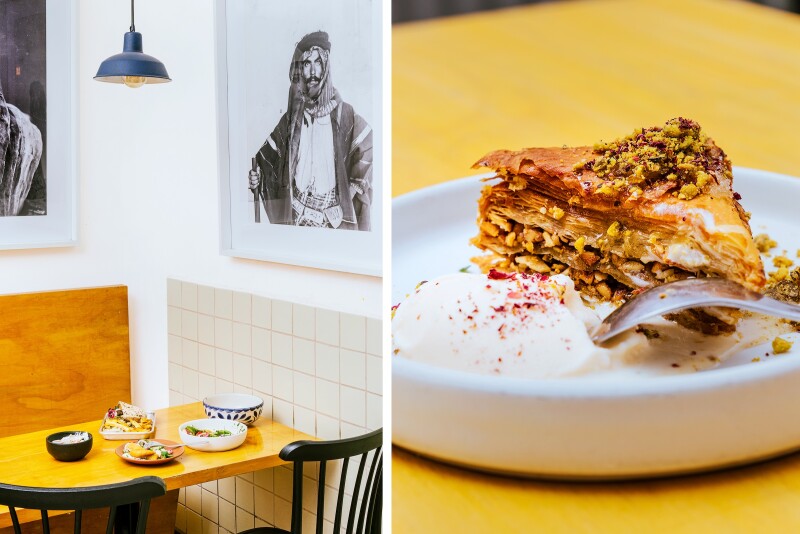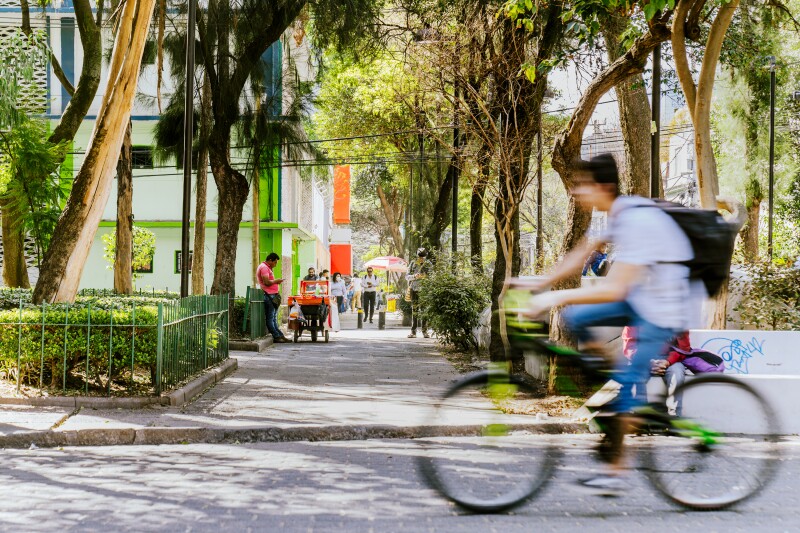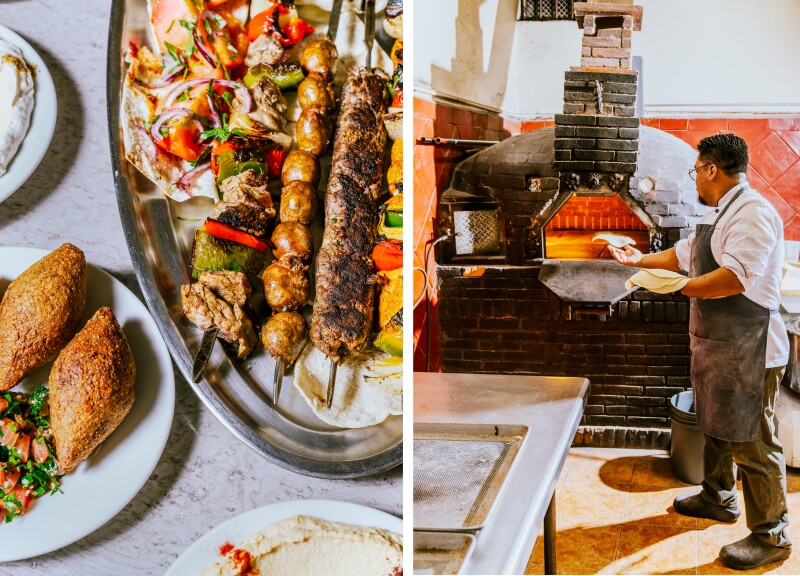This story is from a print issue of Afar. To receive quarterly issues of Afar's award-winning print magazine, full of stories and inspiration for discerning travelers, sign up today.
Growing up in the Mexican capital, Andrea Sayeg, now 33, dreamed of opening her own taco shop where she would serve suadero, lengua, maciza, and other cuts of meat typically found in Mexico City’s taquerias. But the restaurant she actually opened in 2021 ended up looking nothing like that: At Alay Alay, Sayeg’s specialty taco features crispy fried chicken bathed in muhammara, a sauce of red peppers, almonds, cashews, pine nuts, and pomegranate syrup. It’s the perfect symbol of her combined culinary influences—the foods of her Lebanese heritage and of her Mexico City hometown.
Sayeg found that the two cuisines work well together. “We use a lot of cumin in Mexican food and also in the Middle East. We use a lot of oregano [here], and in the Middle East it’s za’atar.” Not only do the cuisines incorporate similar ingredients, but they also embody a similar approach to complex, layered flavors. Where a Mexican mole might call for 21 components, Sayeg notes that “in the Middle East, it’s the same thing. A lot of ingredients in one recipe.”
Alay Alay is part of a wave of Middle Eastern restaurants in Mexico City that are reexamining the culinary legacy of the hundred of thousands of Lebanese and Syrians who poured into Mexico between the late 19th and mid-20th centuries, including Sayeg’s great-grandmother. The immigrants came for many reasons—economic needs, religious freedom, to escape war. Their most famous gift is tacos al pastor, a descendent of shawarma and a signature food of Mexico City.
At places like El Vilsito, an auto shop in the Narvarte neighborhood that turns into a taco stand at night, taqueros carve spiced pork from the trompo (a vertical spit), wielding foot-long knives with the skill of a surgeon, the meat falling into a waiting corn tortilla. Another deft slash rains roasted pineapple on top.

A meal on display at PatPatz restaurant in the Juárez neighborhood of Mexico City. Clockwise from far left are labneh with mint and watermelon, a roasted beet and falafel pita sandwich, the mezze sampler, and a salad; Baklava served with ice cream, garnished with honey, pistachio, and rose petals, from PatPatz.
Photo by Jake Naughton
In the residential Del Valle neighborhood, Sayeg’s cartooned face smiles down from Alay Alay’s storefront. The pink logo highlights both her break from the typical stuffiness of the city’s Middle Eastern cuisine and the rarity of a woman at the trompo. In Sayeg’s dishes, she combines techniques and recipes passed down from her grandmother with her own years of hands-on experience as executive chef at Mexico City’s Israeli fine-dining spot Merkavá. “We do traditional food with different techniques, a bit more modern, different ingredients,” she says of Alay Alay. Some of the changes are practical: It’s hard to get Aleppo chili in Mexico, so she uses chile de árbol and ancho. Others are functional: The house-made pita recipe uses yogurt and clarified butter to maximize fluffiness without heft, so that it can wrap like a taco. And some are just fun, like the option to add a costra, or cheese crust, to the pita, as offered at many trendy taco shops.
That lighthearted irreverence shows up on the T-shirts at chef Mijael Seidel’s Pàt Patz, too: “Great Fk*ng Kebabs.” His father owned a vegan taco shop in Mexico City in the 1970s, so Seidel knew about the business—and about pushing norms. But it wasn’t until he moved to New York City in 1999 for a short-lived graphic design career that he connected the two cuisines. The savory, sour, fatty flavors from a halal cart outside a Queens subway station reminded him of the cuisine from his home in Colima, Mexico—much more so than any taco truck he’d sampled in New York. “A lot of [Middle Eastern] flavors and spices influenced me throughout my childhood,” Seidel, 42, explains. “I didn’t eat them in Middle Eastern food, but we ate a lot of lentils, cumin, yogurt, and I was always looking for those flavors.” The cart’s dishes, he says, “tasted like what I knew as Mexican.”

A biker speeds past in the Plaza de Rio de Janeiro in the Roma Norte neighborhood of Mexico City.
Photo by Jake Naughton
When Seidel returned to Mexico in 2009, he missed the heaping meals so much that he offered to buy the cart’s recipes. The price tag put them out of reach, so instead he developed his own falafel-and-rice platter, which he served from an old hot dog cart in Colima. When he added a kebab, customers called it the best in the city––which meant little to Seidel until Colima’s few Middle Eastern residents echoed the sentiment. With that vote of confidence, he moved to a catering kitchen in Mexico City in 2020 and was named one of Food & Wine en Español’s “Best New Chefs” the same year. In June 2022, Pàt Patz upgraded to its current brick-and-mortar restaurant in the hip Juárez neighborhood.
To diners, Pàt Patz’s menu of hummus, kebabs, and falafel can look like a list of Middle Eastern standards, until the bright flavors explode from the plate. His smoked brisket pita sandwiches, for example, subvert expectations with horseradish sauce, pickles, tahini, and salsa macha. “The vegetables are as important to the pita sandwich as the meat,” Seidel says, something that he found took Mexican customers by surprise, even though he dresses his salads to please local sensibilities—heavy on the chilies and lime. “I come from Colima, the lime capital of the world,” Seidel says. “We put lime on everything, and the acidity makes flavors pop.” When customers wonder aloud if pickles are strange or there are too many vegetables, he lets those big, familiar tastes serve as the rebuttal. “People who try it have no argument,” Seidel says with a smile.
Shaking up two culinary legacies at once can sometimes leave this new generation of chefs straddling the line between the food they want to cook and what customers expect. One of the ways immigrants preserved their heritage here, Seidel observes, “was by not messing around with how the food was prepared.” So even as Middle Eastern cuisine evolved elsewhere, it remained static in Mexico City for a long time. As that’s been changing, Sayeg has fielded similar questions of authenticity from some customers—including her own father. But once he tasted Alay Alay’s tacos, he offered what might be the best summary of the burgeoning fusion style and its impact on Mexico City’s dining scene: “It’s not like my mom made, but it’s delicious.”

The Shawarma Yemenita taco from Alay Alay Taquera de Medio Oriente, served with a side of tabouleh and yoghurt with cucumber; Jose Rodriguez bakes bread at al-Andalus restaurant in the Historic Center neighborhood of Mexico City
Photo by Jake Naughton
Where to taste the Middle East in Mexico City
Alay Alay
Location: Matías Romero 98, Colonia del Valle
Chef Andrea Sayeg dreams up creative riffs on classic Middle Eastern dishes, wrapped in fluffy pita bread instead of tortillas. Try the Lebanese-style pork quesadillas or seasonal lamb kebab taco.
Pàt Patz
Location: Oslo 7, Colonia Juárez
Mijael Seidel’s restaurant draws inspiration from a Palestinian-owned food cart he loved in New York City, but the dishes—such as the brisket kebab with macha sauce—are dressed in the bold flavors of his home of Colima, Mexico.
El Vilsito
Location: Avenida Universidad 248, Narvarte Poniente
In the evening, this auto shop turns into one of the best spots to find the city’s classic fusion dish, tacos al pastor, a descendant of shawarma brought by Middle Eastern immigrants.
Al-Andalus
Location: Mesones 171, Centro Histórico, Av. Insurgentes Sur 2475, Torre Aleph Piso 1, San Ángel
Set in the 17th-century colonial building in the historic city center, this elegant stalwart has long served Lebanese dishes such as kibbe and kebabs. But even the old guard sees the appeal of evolving: In 2022, Al-Andalus opened a second spot in the upscale neighborhood of San Ángel, where a more wide-ranging menu reflects a combination of flavors such as hummus eggs Benedict and a baklava with burrata.











